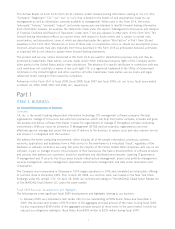Computer Associates 2009 Annual Report Download - page 21
Download and view the complete annual report
Please find page 21 of the 2009 Computer Associates annual report below. You can navigate through the pages in the report by either clicking on the pages listed below, or by using the keyword search tool below to find specific information within the annual report.We may encounter difficulties in successfully integrating companies and products that we have acquired or may acquire
into our existing business and, therefore, such failed integration could materially adversely affect our infrastructure,
market presence, or results of operations.
In the past we have acquired, and in the future we expect to acquire complementary companies, products, services and
technologies (including through mergers, asset acquisitions, joint ventures, partnerships, strategic alliances, and equity
investments). The risks we may encounter include:
•We may find that the acquired company or assets do not further improve our financial and strategic position as
planned;
•We may have difficulty integrating the operations, facilities, personnel and commission plans of the acquired
business;
•We may have difficulty forecasting or reporting results subsequent to acquisitions;
•We may have difficulty retaining the technical skills needed to provide services on the acquired products;
•We may have difficulty incorporating the acquired technologies or products with our existing product lines;
•We may have product liability, customer liability or intellectual property liability associated with the sale of the
acquired company’s products;
•Our ongoing business may be disrupted by transition or integration issues; our management’s attention may be
diverted from other business concerns;
•We may be unable to obtain timely approvals from governmental authorities under applicable competition and
antitrust laws;
•We may have difficulty maintaining uniform standards, controls, procedures and policies;
•Our relationships with current and new employees, customers and distributors could be impaired;
•An acquisition may result in increased litigation risk, including litigation from terminated employees or third parties;
•We may have difficulty with determinations related to accounting matters, including those that require a high degree
of judgment or complex estimation processes, including valuation and accounting for goodwill and intangible assets,
stock-based compensation, and income tax matters; and
•Our due diligence process may fail to identify significant issues with the acquired company’s product quality, financial
disclosures, accounting practices, internal control deficiencies, including material weaknesses, product architecture,
legal contingencies and other matters.
These factors could have a material adverse effect on our business, results of operations, financial condition and cash
flow, particularly in the case of a large acquisition or number of acquisitions. To the extent we issue shares of stock or
other rights to purchase stock, including options, to pay for acquisitions or to retain employees, existing stockholders’
interests may be diluted and net income per share may decrease.
We are subject to intense competition in product and service offerings and pricing, and we expect to face increased
competition in the future, which could either diminish demand for or inhibit growth of our products and, therefore,
reduce our sales, revenue and market presence.
The markets for our products are intensely competitive, and we expect product and service offerings and pricing
competition to increase. Some of our competitors have longer operating histories, greater name recognition, a larger
installed base of customers in any particular market niche, larger technical staffs, established relationships with hardware
vendors or greater financial, technical and marketing resources. We also face competition from numerous smaller
companies that specialize in specific aspects of the highly fragmented software industry, and from shareware authors that
may develop competing products. In addition, new companies enter the market on a frequent and regular basis, offering
products that compete with those offered by us. Moreover, certain customers historically have developed their own
products that compete with those offered by us. The competition may affect our ability to attract and retain the technical
skills needed to provide services to our customers, forcing us to become more reliant on delivery of services through third
parties. This, in turn, could increase operating costs and decrease our revenue, profitability and cash flow. Additionally,
11
























